Nuclear medicine on the example of technetium
If you recall the practical benefits of the discovery of the chain reaction of uranium fission, then immediately after weapons and energy, perhaps, there will be methods of nuclear medicine. Nuclear phenomena are used both in diagnostics and radiation therapy. I would like to use the example of the technetium 99m Tc radioactive isotope to show how nuclear reactors help with oncology diagnostics.
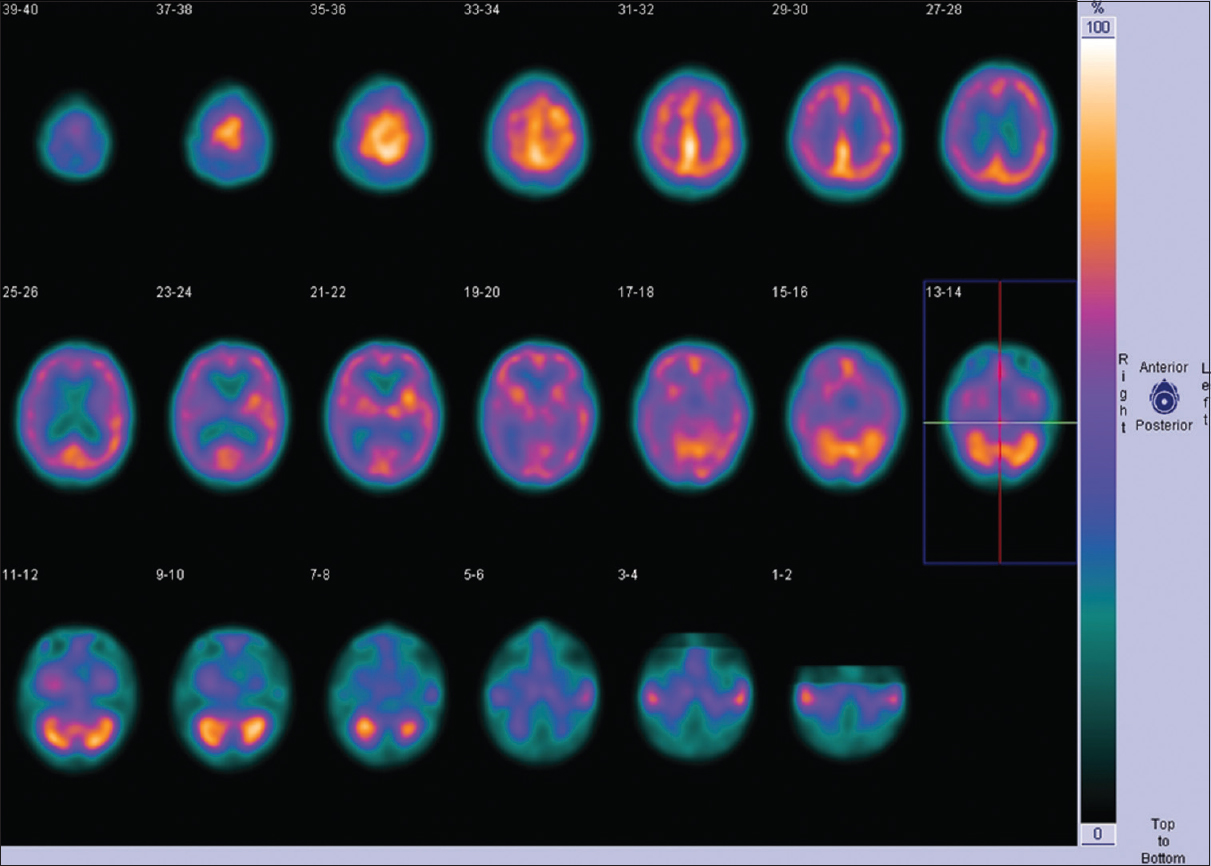
Tomographic cuts of the intensity of gamma radiation of a 99m Tc labeled drug.
The technetium 99m Tc short-lived isomer is a probe (tracer) whose movement through the body and accumulation can be monitored using tomography of gamma rays emitted during the isomeric transition of this nuclide. It has a short half-life (T = 6.04 hours, decaying into the ground state 99 Tc, is also a radioactive isotope, but with a half-life already 214 thousand years), technetium has no stable isotopes, it is unfamiliar to our biochemistry, therefore it is not embedded in metabolic pathways in the body and rapidly excreted. Another important useful property is the γ-radiation energy (140 keV) - it is large enough to penetrate the tissue and small enough to not cause their overexposure.
')
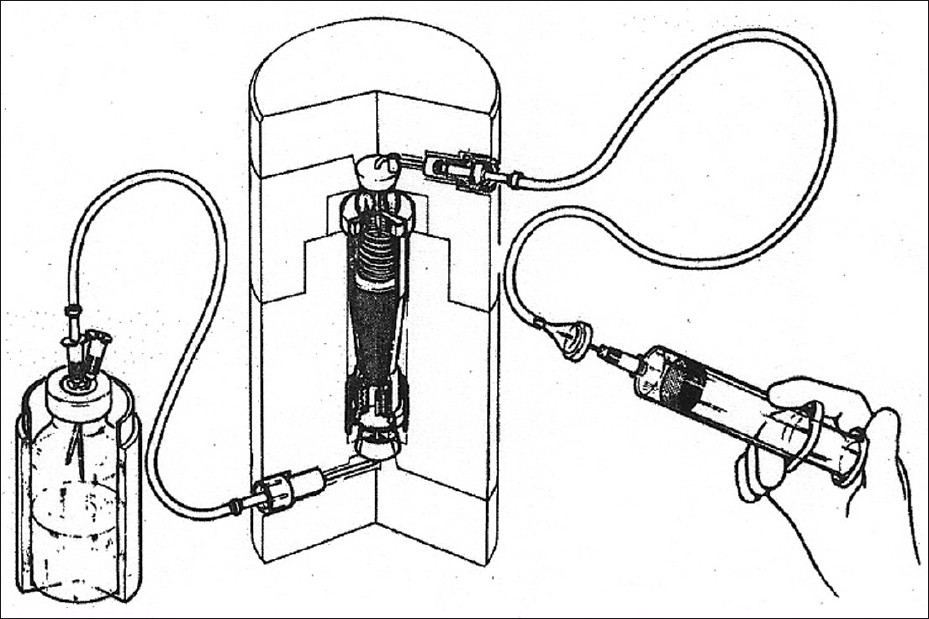
A diagram illustrating the production of technetium by washing the column with the parent isotope, which is in lead protection with a special medium that washes out technetium.
As a result, today in the world 80% of diagnostic procedures using radiopharmaceuticals account for 99m Tc - this is about 30 million procedures per year, in technetium money - about 1/4 of all nuclear medicine. Diagnosis by a tracer looks like a study of the dynamics of movement in the body of specially selected drug molecules with technetium; Wikipedia knows many such substances for the diagnosis of various types of cancer. In this case, usually the labeling drug accumulates (or does not accumulate) in the patient (healthy) organ, and this is easy to see with a single photon scintillation tomograph.

Actually, here it is - one-photon (as opposed to PET tomographs, recording two photons of annihilation of positrons beta plus decay) scintillation tomograph.
However, as it seems to me, much more striking than the diagnosis itself, the thing is receiving the radiopharmaceutical. Think about it: the technetium half-life is 6 hours - in 24 hours 94% of this isotope falls apart, which means that the drug cannot be bought at the pharmacy, and it is difficult to transport it: even moving it around the city can lose half of the activity. Let's unwind the chain of the diagnostic procedure from the end to the beginning, and then we will look at the global market of this isotope.
As you can already guess, technetium preparations for diagnosis are obtained directly in the hospital with the help of radiochemistry procedures that are rather frightening in their seriousness. 99m Tc is the only daughter isotope of radioactive molybdenum 99 Mo, whose half-life is 2.75 days. Molybdenum 99 is delivered to the hospital in the form of technetium generators - lead containers containing a column with precipitated molybdenum.
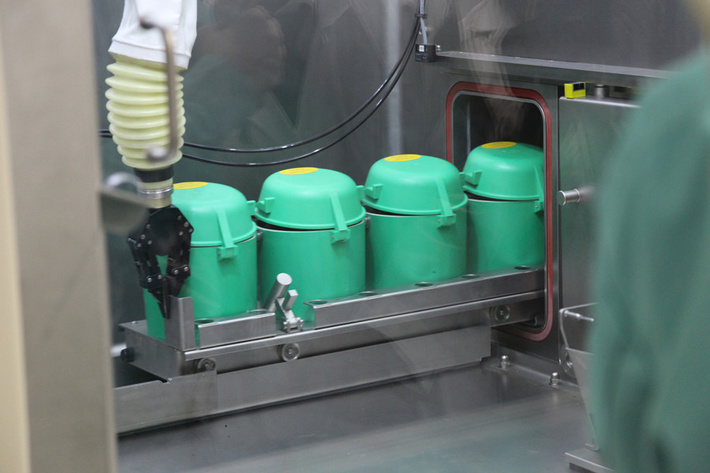
Technetium Generators Alive ...

And in the cut.
A 20-kilogram generator usually contains from 0.5 to 5 Curies (Curie is such a unit of activity, a certain number of decays per second. Another similar unit is Becquerel (Bq), one Ki equals 3.7 * 10 10 Bq) actively decaying molybdenum. To obtain a radio chemical preparation, a chemical is washed through the column that elutes (captures) technetium. Usually, for this purpose, two ampoules are put on the generator: one with an eluent, and the other with a vacuum, and a lead screen is put on the vacuum ampoule.
Finally, by dialing a 99m Tc solution, a radiopharmaceutical is prepared at its base. Take the time to watch the video below: the rules for handling a radioactive pharmacy suggest that it is not very useful to inject it :) The average diagnostic test requires about 250 MBq (0.06 Ci) of technetium and results in a dose of 50 mSv ( 5 rem) - approximately one maximum permissible annual dose for NPP personnel.
The next question is: where do technetium generators filled with 99 Mo come from? This is where nuclear reactors come into play. 99Mo is one of the fragments of 235U, in its fission products of uranium it is about 6.3%. Any working gigawattnik contains hundreds of grams of this isotope in its fuel, while consumption for medical needs is only about 1 gram per year. However, only stopping and removing fuel assemblies from a powerful power reactor takes so much time (several days) that practically nothing remains of molybdenum.
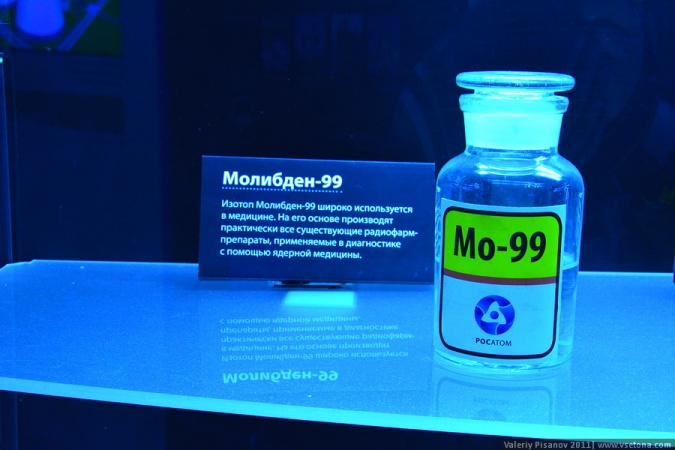
By taking a flask with a real solution of molybdenum-99 in your hand, you can lose this hand - the radioactivity of such a flask will be about 100 roentgens per second on the surface.
Therefore, 99 Mo is obtained by irradiating small (tens of grams) targets from highly enriched 235U at research reactors (the presence of 238 isotopes in the target gives unwanted radiotoxic transuranium elements: plutonium, neptunium, americium). After extraction from the reactor, the targets are kept for 1-2 days to break up even more active fragments than molybdenum, then dissolve in nitric acid or alkali and 99 Mo are extracted by chemical means in a hot chamber. Finally, the purified solution with radioactive molybdenum is transferred to the production of technetium generators, where it is charged into a sorption column. The latter process also takes place in hot cells, but not only that - at GMP production (a system of pharmaceutical production standards that ensures sterility and quality of preparations).

Generally speaking, the efficiency of the process of extracting 99 Mo from a uranium target is low: in addition to the meager part of expensive uranium 235 being used, only a few percent of accumulated molybdenum will get into the technetium generators - the rest will go with the remaining fission products into radioactive waste or decompose before processing . Small efficiency, work with weapons-grade uranium, a large amount of radioactive waste determine the high cost of molybdenum - about $ 50 million per gram in the generator. Saves only the fact that this gram allows you to spend tens of millions of tests.
As a result, the production chain of diagnostics with 99m Tc looks like this: production of targets from HEU -> reactor -> hot chambers (preferably next to the reactor) -> GMP hot chambers for charging technetium generators -> room in a hospital for working with radioactive drugs. The current demand is 12,000 Curies per week, and there are a dozen reactors in the world that target irradiation, but of these, the vast majority of molybdenum is supplied by the Canadian NRU reactor (4800 curies per week) located in Chalk River, the Netherlands HFR (2500 Ci) from Petten , Belgian BR-2 (which should replace MYRRHA ) and French OSIRIS; together they are responsible for 80% of the market of this nuclide. Nearby are also the largest converters of targets Nordion in Canada, Mallinckrodt in the Netherlands, IRU in Belgium.
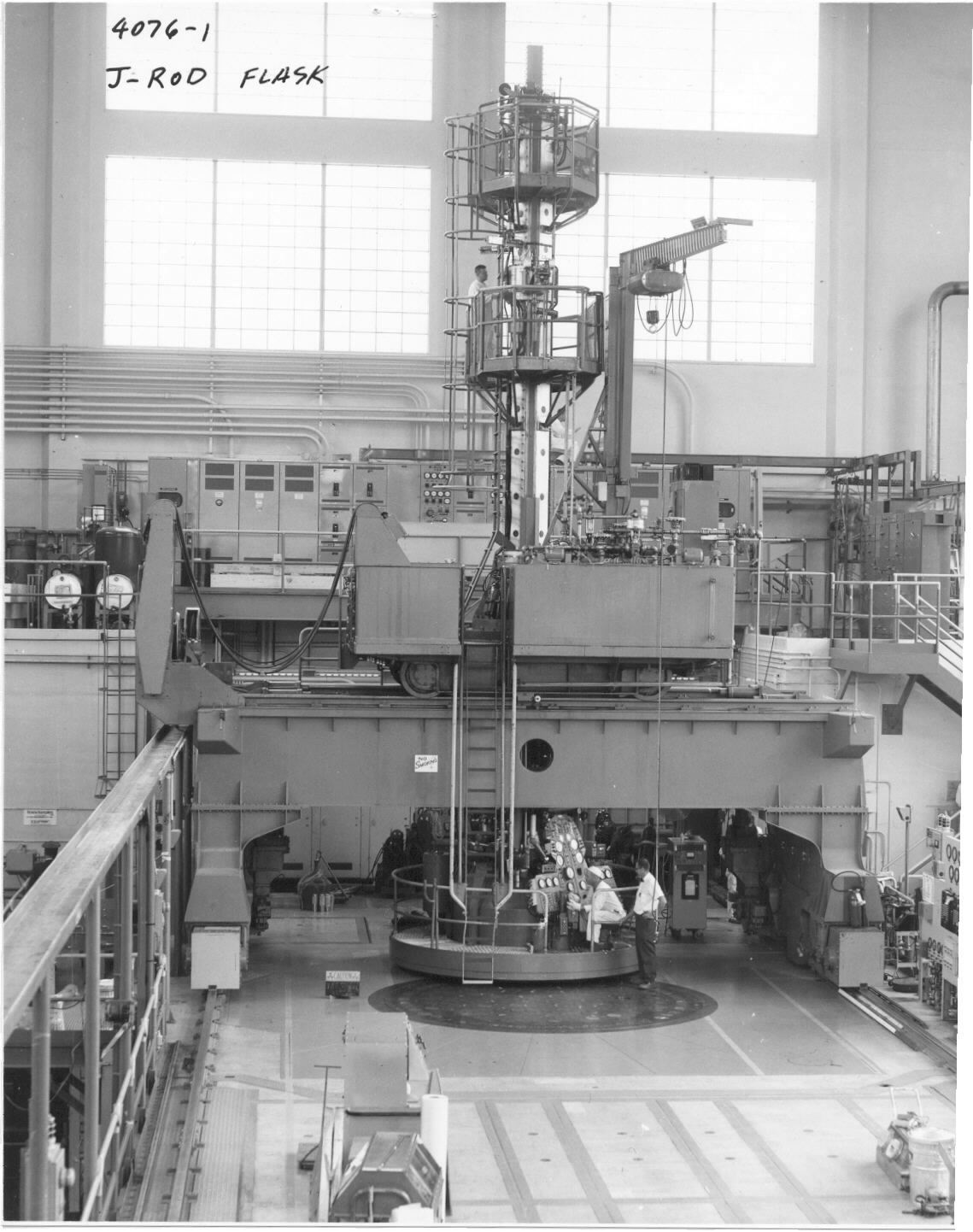
The Canadian NRU reactor uses a powerful reloading machine that you expect to see rather at a nuclear power plant. Its 135 megawatt thermal capacity is one of the most powerful research reactors in the world.
However, in 2010, the company that emerged in the 80s, a domestic supplier of 99 Mo burst into action - a well-known institute, NIIAR, which possesses the most powerful fleet of irradiation reactors. Radiation is conducted at the SM reactor known to us , reprocessing is carried out on the ROMOL-99 radiochemical line, and the largest research reactor park in the world (up to one site) allows up to 25% of world needs to be produced, which was used in the early 2010s by Canadians during the closure NRU reactor for repairs and upgrades. In general, the aging of the main medical radioisotope-producing reactors increases the potential of Rosatom and other new manufacturers (for example, the new OPAL research reactor in Australia) to conquer the market.
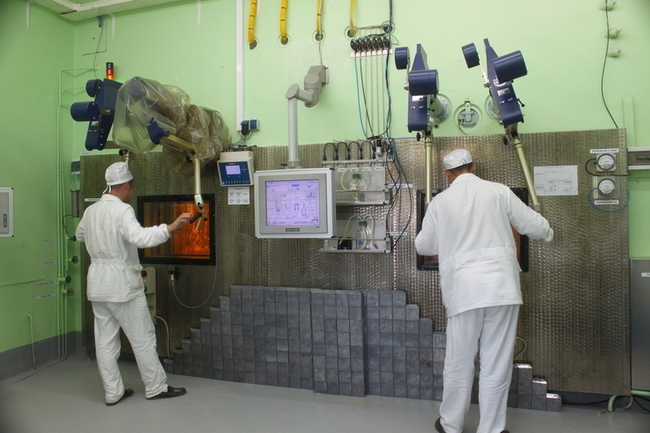
The unsightly ROMOL-99 (view from the operators) is capable of meeting 25% of the global demand for molybdenum-99
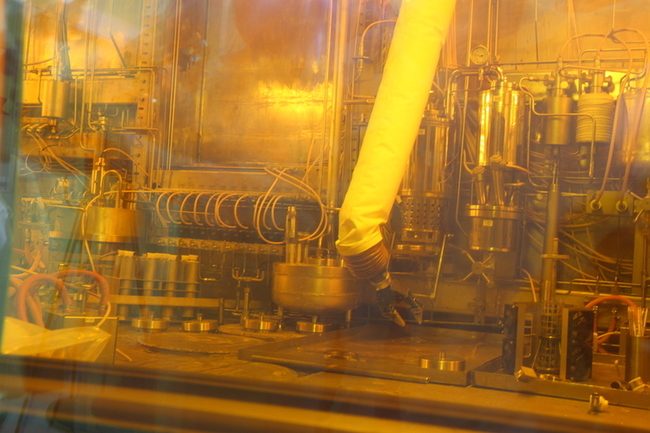
She's inside the hot chamber.
There is in Russia and the production of a full cycle. The L.Ya.Karpov NIFHI (located in Obninsk) irradiates targets in its VVR-c basin reactor with a capacity of 15 megawatts.
Irradiation is carried out in 4 channels of the reactor, where special assemblies with external cooling are loaded.

Appearance VVR-ts
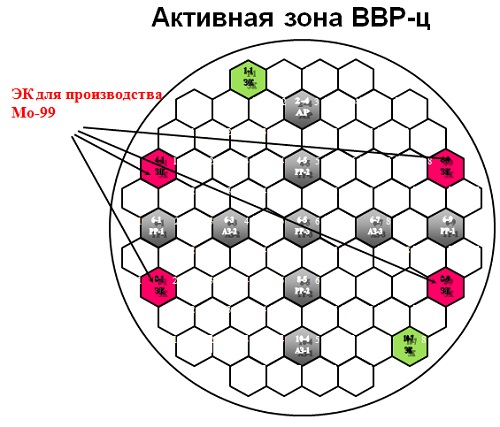
Targets are irradiated in the reactor for about a week, after which they are extracted, kept for two days for the decay of the most active fission fragments and processed in hot cells of the NIFHI.
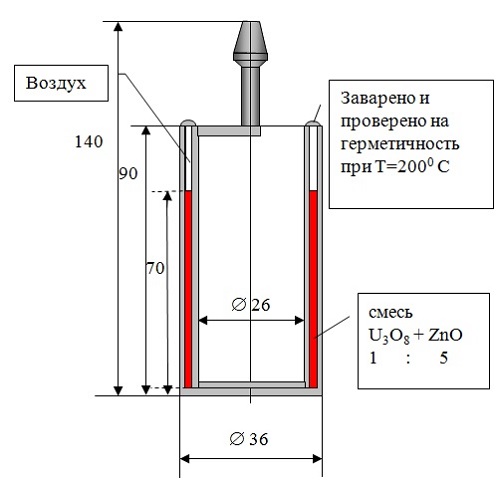
Drawing of a single target. It can be seen that there is quite a bit of uranium

99Mo solution hot chamber
NIFHI manufactures technetium generators in its GMP production. Its capacity is about 200 generators per week, from each of which you can get up to 20 servings of technetium for diagnosis. Charging the generators, like all the other stages, is hard work in a hot cell.
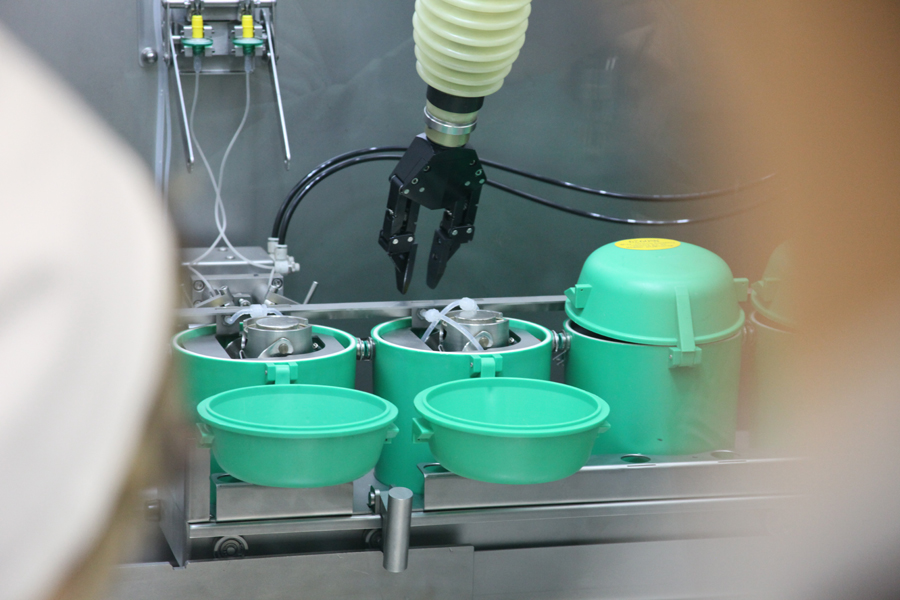
Technetium generators are charged under sterile and radiation-protected conditions.
The market of irradiated targets today is about $ 50 million, molybdenum solution is $ 80 million, technetium generators are $ 150, and medical procedures are $ 2 billion. Such a market already fully pays for the creation of special facilities for obtaining 99Mo, and the development is mainly aimed at creating activation or fragmentation accelerator machines, i.e. Accelerators with a neutron source (like ESS), causing the forced fission reaction of U238 or neutron capture in a 98Mo target. So far, these developments provide more expensive molybdenum than in already built reactors, but cheaper than if the reactor had to be built specifically for the production of medical radioisotopes. In addition, such accelerator plants can be placed directly in hospitals (there are already quite a lot of accelerators for the therapy and production of short-lived diagnostic isotopes — for example, 18F) in hospitals, as opposed to reactors.
PS Studying this topic, I found for myself that in Thailand there is a research reactor of the widespread TRIGA series, which also receive medical radioisotopes . More surprisingly, he has been there since 1972.

Tomographic cuts of the intensity of gamma radiation of a 99m Tc labeled drug.
The technetium 99m Tc short-lived isomer is a probe (tracer) whose movement through the body and accumulation can be monitored using tomography of gamma rays emitted during the isomeric transition of this nuclide. It has a short half-life (T = 6.04 hours, decaying into the ground state 99 Tc, is also a radioactive isotope, but with a half-life already 214 thousand years), technetium has no stable isotopes, it is unfamiliar to our biochemistry, therefore it is not embedded in metabolic pathways in the body and rapidly excreted. Another important useful property is the γ-radiation energy (140 keV) - it is large enough to penetrate the tissue and small enough to not cause their overexposure.
')

A diagram illustrating the production of technetium by washing the column with the parent isotope, which is in lead protection with a special medium that washes out technetium.
As a result, today in the world 80% of diagnostic procedures using radiopharmaceuticals account for 99m Tc - this is about 30 million procedures per year, in technetium money - about 1/4 of all nuclear medicine. Diagnosis by a tracer looks like a study of the dynamics of movement in the body of specially selected drug molecules with technetium; Wikipedia knows many such substances for the diagnosis of various types of cancer. In this case, usually the labeling drug accumulates (or does not accumulate) in the patient (healthy) organ, and this is easy to see with a single photon scintillation tomograph.

Actually, here it is - one-photon (as opposed to PET tomographs, recording two photons of annihilation of positrons beta plus decay) scintillation tomograph.
However, as it seems to me, much more striking than the diagnosis itself, the thing is receiving the radiopharmaceutical. Think about it: the technetium half-life is 6 hours - in 24 hours 94% of this isotope falls apart, which means that the drug cannot be bought at the pharmacy, and it is difficult to transport it: even moving it around the city can lose half of the activity. Let's unwind the chain of the diagnostic procedure from the end to the beginning, and then we will look at the global market of this isotope.
As you can already guess, technetium preparations for diagnosis are obtained directly in the hospital with the help of radiochemistry procedures that are rather frightening in their seriousness. 99m Tc is the only daughter isotope of radioactive molybdenum 99 Mo, whose half-life is 2.75 days. Molybdenum 99 is delivered to the hospital in the form of technetium generators - lead containers containing a column with precipitated molybdenum.

Technetium Generators Alive ...

And in the cut.
A 20-kilogram generator usually contains from 0.5 to 5 Curies (Curie is such a unit of activity, a certain number of decays per second. Another similar unit is Becquerel (Bq), one Ki equals 3.7 * 10 10 Bq) actively decaying molybdenum. To obtain a radio chemical preparation, a chemical is washed through the column that elutes (captures) technetium. Usually, for this purpose, two ampoules are put on the generator: one with an eluent, and the other with a vacuum, and a lead screen is put on the vacuum ampoule.
Finally, by dialing a 99m Tc solution, a radiopharmaceutical is prepared at its base. Take the time to watch the video below: the rules for handling a radioactive pharmacy suggest that it is not very useful to inject it :) The average diagnostic test requires about 250 MBq (0.06 Ci) of technetium and results in a dose of 50 mSv ( 5 rem) - approximately one maximum permissible annual dose for NPP personnel.
The next question is: where do technetium generators filled with 99 Mo come from? This is where nuclear reactors come into play. 99Mo is one of the fragments of 235U, in its fission products of uranium it is about 6.3%. Any working gigawattnik contains hundreds of grams of this isotope in its fuel, while consumption for medical needs is only about 1 gram per year. However, only stopping and removing fuel assemblies from a powerful power reactor takes so much time (several days) that practically nothing remains of molybdenum.

By taking a flask with a real solution of molybdenum-99 in your hand, you can lose this hand - the radioactivity of such a flask will be about 100 roentgens per second on the surface.
Therefore, 99 Mo is obtained by irradiating small (tens of grams) targets from highly enriched 235U at research reactors (the presence of 238 isotopes in the target gives unwanted radiotoxic transuranium elements: plutonium, neptunium, americium). After extraction from the reactor, the targets are kept for 1-2 days to break up even more active fragments than molybdenum, then dissolve in nitric acid or alkali and 99 Mo are extracted by chemical means in a hot chamber. Finally, the purified solution with radioactive molybdenum is transferred to the production of technetium generators, where it is charged into a sorption column. The latter process also takes place in hot cells, but not only that - at GMP production (a system of pharmaceutical production standards that ensures sterility and quality of preparations).

Generally speaking, the efficiency of the process of extracting 99 Mo from a uranium target is low: in addition to the meager part of expensive uranium 235 being used, only a few percent of accumulated molybdenum will get into the technetium generators - the rest will go with the remaining fission products into radioactive waste or decompose before processing . Small efficiency, work with weapons-grade uranium, a large amount of radioactive waste determine the high cost of molybdenum - about $ 50 million per gram in the generator. Saves only the fact that this gram allows you to spend tens of millions of tests.
As a result, the production chain of diagnostics with 99m Tc looks like this: production of targets from HEU -> reactor -> hot chambers (preferably next to the reactor) -> GMP hot chambers for charging technetium generators -> room in a hospital for working with radioactive drugs. The current demand is 12,000 Curies per week, and there are a dozen reactors in the world that target irradiation, but of these, the vast majority of molybdenum is supplied by the Canadian NRU reactor (4800 curies per week) located in Chalk River, the Netherlands HFR (2500 Ci) from Petten , Belgian BR-2 (which should replace MYRRHA ) and French OSIRIS; together they are responsible for 80% of the market of this nuclide. Nearby are also the largest converters of targets Nordion in Canada, Mallinckrodt in the Netherlands, IRU in Belgium.

The Canadian NRU reactor uses a powerful reloading machine that you expect to see rather at a nuclear power plant. Its 135 megawatt thermal capacity is one of the most powerful research reactors in the world.
However, in 2010, the company that emerged in the 80s, a domestic supplier of 99 Mo burst into action - a well-known institute, NIIAR, which possesses the most powerful fleet of irradiation reactors. Radiation is conducted at the SM reactor known to us , reprocessing is carried out on the ROMOL-99 radiochemical line, and the largest research reactor park in the world (up to one site) allows up to 25% of world needs to be produced, which was used in the early 2010s by Canadians during the closure NRU reactor for repairs and upgrades. In general, the aging of the main medical radioisotope-producing reactors increases the potential of Rosatom and other new manufacturers (for example, the new OPAL research reactor in Australia) to conquer the market.

The unsightly ROMOL-99 (view from the operators) is capable of meeting 25% of the global demand for molybdenum-99

She's inside the hot chamber.
There is in Russia and the production of a full cycle. The L.Ya.Karpov NIFHI (located in Obninsk) irradiates targets in its VVR-c basin reactor with a capacity of 15 megawatts.
Irradiation is carried out in 4 channels of the reactor, where special assemblies with external cooling are loaded.

Appearance VVR-ts

Targets are irradiated in the reactor for about a week, after which they are extracted, kept for two days for the decay of the most active fission fragments and processed in hot cells of the NIFHI.

Drawing of a single target. It can be seen that there is quite a bit of uranium

99Mo solution hot chamber
NIFHI manufactures technetium generators in its GMP production. Its capacity is about 200 generators per week, from each of which you can get up to 20 servings of technetium for diagnosis. Charging the generators, like all the other stages, is hard work in a hot cell.

Technetium generators are charged under sterile and radiation-protected conditions.
The market of irradiated targets today is about $ 50 million, molybdenum solution is $ 80 million, technetium generators are $ 150, and medical procedures are $ 2 billion. Such a market already fully pays for the creation of special facilities for obtaining 99Mo, and the development is mainly aimed at creating activation or fragmentation accelerator machines, i.e. Accelerators with a neutron source (like ESS), causing the forced fission reaction of U238 or neutron capture in a 98Mo target. So far, these developments provide more expensive molybdenum than in already built reactors, but cheaper than if the reactor had to be built specifically for the production of medical radioisotopes. In addition, such accelerator plants can be placed directly in hospitals (there are already quite a lot of accelerators for the therapy and production of short-lived diagnostic isotopes — for example, 18F) in hospitals, as opposed to reactors.
PS Studying this topic, I found for myself that in Thailand there is a research reactor of the widespread TRIGA series, which also receive medical radioisotopes . More surprisingly, he has been there since 1972.
Source: https://habr.com/ru/post/369643/
All Articles